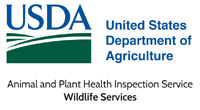United States Department of Agriculture: Animal and Plant Health Inspection Service

United States Department of Agriculture Wildlife Services: Staff Publications
Document Type
Article
Date of this Version
2020
Citation
Global Ecology and Conservation 22 (2020) e00986
Abstract
Invasive mammals, particularly black rats (Rattus rattus), house mice (Mus musculus), and mongoose (Herpestes auropunctatus) are established on many tropical islands and threaten natural resources such as native birds, sea turtles, lizards, invertebrates, and plants. St. Croix (U.S. Virgin Islands, Caribbean) has a diversity of natural resources being protected from invasive mammals by U.S. conservation agencies. Sandy Point National Wildlife Refuge and Buck Island Reef National Monument receive among the highest density of nesting sea turtles in the region, including annual nesting populations of 50e250 leatherbacks (Dermochelys coriacea), 25e80 hawksbills (Eretmochelys imbricata), and 100e250 green turtles (Chelonia mydas). Buck Island Reef National Monument and Green Cay National Wildlife Refuge are small islands near St. Croix Island that have endangered St. Croix ground lizards (Ameiva polops) established. Rodents and mongoose threaten each of these natural resources. The goal of our study was to determine the types of small mammals (i.e., mongoose, rats, and/or house mice) that are established in each of the three hotspot locations mentioned, and to determine how two severe hurricanes (Irma and Maria) affected the small mammal populations. We used traps and tracking tunnels, which are baited ink cards placed in tunnels so that animal foot prints can be identified, to determine presence and relative abundances of small mammal species. We found that: 1) black rats invaded and established, possibly by rafting and/or swimming, Green Cay following the hurricanes, 2) house mice, rats, and mongoose were present before and after the hurricanes at Sandy Point (mice had not been documented prior to our sampling), and house mouse abundance significantly increased (>2.5 times pre-hurricane levels) 9-months after the hurricanes, and 3) the house mouse population more than doubled 15-months after the hurricanes on Buck Island. Land and resource managers benefit from knowing the composition and relative abundances of the small mammal communities, and the presence of house mice will make predator-free management efforts challenging. Surveillance using tracking tunnels enables rapid confirmation of new invasive species in isolated habitats and following large storms, as demonstrated by our finding that black rats established on Green Cay following the 2017 hurricanes.
Included in
Natural Resources and Conservation Commons, Natural Resources Management and Policy Commons, Other Environmental Sciences Commons, Other Veterinary Medicine Commons, Population Biology Commons, Terrestrial and Aquatic Ecology Commons, Veterinary Infectious Diseases Commons, Veterinary Microbiology and Immunobiology Commons, Veterinary Preventive Medicine, Epidemiology, and Public Health Commons, Zoology Commons


Comments
CC-BY-NC-ND